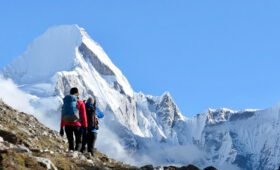Nepali, the official language of Nepal, is widely spoken in various regions including India and Bhutan. With approximately 28 million speakers, it is considered one of the most prevalent Indo-Aryan languages globally. Furthermore, Nepali is recognized as one of the 22 scheduled languages in India as per the Indian constitution. Additionally, it holds official language status in Bhutan, where it is spoken by approximately a quarter of the population. In India, Nepali is one of the two official languages in the state of Sikkim and is also spoken in states such as Arunachal Pradesh, Assam, Himachal Pradesh, Manipur, and Uttarakhand. Moreover, the Burmese Gurkhas in Myanmar also communicate in the Nepali language.
The Nepali language has its roots in Sanskrit, dating back to around 1000 AD. Its grammar and phonology share close ties with Hindi and other Indo-Aryan languages. For those seeking to delve deeper into the history and origins of this captivating language, read on to discover more about Nepali.
Origin Of Nepali Language
There are varying opinions regarding the origin of the Nepali language. While some experts argue that it has roots in Sanskrit, a revered Hindu language, others suggest that it is based on Hindustani or Urdu due to the striking similarities in their sound and written forms. The most widely accepted theory is that of a linguistic intrusion from the West or Northwest Himalayas into the Central Himalayas, specifically in the present-day regions of Western Nepal, during the reign of the Khasas, an Indo-Aryan speaking group who migrated from the Northwest. The oldest known Nepali inscription, the Dullu Inscription, is believed to have been written during the reign of King Bhupal Damupal around 981 CE.
Several archaeological and historical investigations have demonstrated that the modern Nepali language is derived from the language spoken by the ancient Khasha people. The Khasha were known to have ruled over a vast territory that encompassed present-day western Nepal, parts of Garhwal and Kumaon in northern India, and certain regions of southwestern Tibet. As a result, the initial name of the Nepali language was Khasa Kura, which translates to Khas language. There is substantial evidence supporting this theory, including the discovery of a copper-plate inscription in Bodh Gaya, attributed to King Ashoka Challa, who proclaimed himself Khasha-Rajadhiraja (emperor of the Khashas). Additionally, numerous copper-plates written in the ancient Nepali language have been traced back to the descendants of the King.
The Ashoka Challa inscription from 1255 and the Svastanivratakatha manuscript from 1648 are among the earliest examples of modern Nepali language. Other literary texts from this period include an anonymous version of the “Khandakhadya” from 1649, “Bajapariksha” from 1700, “Jvarotpatticikitsa” by Banivilas Jytoirvid from 1773, and “Prayascittapradipa” by Premnidhi Pant from 1780.
The 1670 Rani Pokhari inscription of King Pratap Malla is an early example of modern Nepali language, indicating the significant increase in Nepali speakers in Kathmandu valley. The current popular variant of Nepali is thought to have originated approximately 500 years ago, when a group of Khas people migrated from the Karnali-Bheri-Seti region to settle in the lower valleys of the Karnali and Gandaki basin, which were suitable for rice cultivation. Throughout the centuries, various dialects of Nepali with influences from Sanskrit, Maithili, Hindi, and Bengali emerged in different regions of present-day Nepal and Uttarakhand, establishing Khasa as the lingua franca.
It’s history in Nepal
The Shah kings of the Gorkha Kingdom are credited with initiating the institutionalization of the Nepali language. This process began in 1559 when Dravya Shah, a prince from Lamjung, established himself as the ruler of the Gorkha Kingdom with the support of local Khas and Magars. Additionally, he assembled an army consisting primarily of Khas individuals. In the 18th century, Prithvi Narayan Shah, a descendant of Dravya Shah, further developed and modernized the Gorkha army by incorporating Chhetri, Thakuri, Magars, Gurung, and other ethnic groups. He embarked on a campaign to conquer and unify numerous small principalities in the Himalayas. As Gorkha replaced the original Khas homeland, the Khas language, known as Khasakura, was renamed Gorkhali, the language of the Gorkhas.
When Prithvi Narayan Shah captured the Kathmandu Valley, which was known as Nepal at that time, he established Kathmandu as his new capital after overthrowing the Malla rulers. The Khas people originally referred to their language as Khas kurā, also known as Parbatiya or Paharia, meaning the language of the hill country. The Newar people, on the other hand, called this language “Gorkhali” as they associated it with the Gorkhali conquerors. Eventually, the Gorkhalis themselves adopted this term to describe their language. Prior to independence, the census of India used the term “Naipali” from 1901 to 1951, which was later replaced with “Nepali” in the 1961 census.
Why Is Nepali Language Unique?
The Nepali language possesses several distinctive characteristics. As previously mentioned, it serves as the official language of Nepal and is also spoken in certain regions of India and Bhutan. Belonging to the Indo-Aryan language family, Nepali exhibits a close relationship with Hindi and Punjabi. Furthermore, it boasts a rich literary heritage and serves as the primary language for numerous renowned Nepali writers. Notably, the Nepali alphabet stands apart with its composition of 48 letters, comprising 13 vowels and 35 consonants. Remarkably, Nepali remains faithful to its original form, adhering to a left-to-right writing system. However, akin to other languages that have undergone evolution, Nepali too continues to adapt. Its grammar may undergo modifications as new vocabulary is introduced into the language. The process of globalization has resulted in a greater number of Nepali speakers residing outside of Nepal, who have been influenced by diverse life experiences, consequently shaping their unique styles of speech and writing in their respective vernaculars.
The translation of Nepali writers’ works into English has led to a growing presence of their literature worldwide. Consequently, various interpretations of standard Nepali have emerged, influenced by regional variations and dialects. The impact of these linguistic shifts on traditional storytelling and creative writing for future generations remains uncertain, as does the transformation of older forms through the lens of younger authors.
Pronunciation Of Nepali Language
In Nepali, the tonal nature of the language requires individuals to modulate their voice, either rising or falling, depending on the specific syllable being pronounced within a word. For instance, uttering the word “MAA” with a level tone signifies “mother,” whereas pronouncing it with an upward inflection at the end, akin to saying “hey!”, conveys the meaning of “horse.” This principle applies to all words in the language, emphasizing the significance of accurately articulating each word with its appropriate tone to ensure comprehension and avoid confusion among listeners.
Major Dialects
Millions of people in Nepal and approximately 13 million individuals worldwide speak the Nepali language (नेपाली भाषा). It is part of the Indo-Aryan language family, which also includes Hindi and Urdu. These languages are all derived from Sanskrit, establishing a linguistic connection among them. Nepali dialects encompass Acchami, Baitadeli, Bajhangi, Bajurali, Bheri, Dadeldhuri, Dailekhi, Darchulali, Darchuli, Gandakeli, Humli, Purbeli, and Soradi. These dialects may differ from Standard Nepali. The level of mutual intelligibility between Baitadeli, Bajhangi, Bajurali (Bajura), Humli, and Acchami is relatively low. The dialect of Nepali spoken in Karnali Province is not mutually understandable with Standard Nepali. In Karnali, the language is referred to by its former name, Khas Bhasa.
Writing System and Scripts of Nepali language
The Nepali language employs a combination of the Devanagari script (देवनागरी) and its own distinct variant of script. The Devanagari-based Nepali alphabets a scripts, there exist numerous other scripts that have been utilized to transcribe various dialects of Nepali throughout history. The prevailing script among contemporary writers is known as Prachalit (प्रचालित). This particular style has been embraced by the majority of modern writers due to its extensive usage since its inception.
How Sasnkrit influenced Nepali Language?
Sanskrit, an ancient Indo-Aryan language, serves as the precursor to various contemporary languages, including Hindi and Bengali. Nepali, which originated from the Prakrit language, is also closely related to Sanskrit. Prakrit, commonly spoken in North India during the 1st millennium CE, is the ancestor of Nepali. Nepali exhibits numerous similarities to Sanskrit, encompassing a sophisticated grammatical structure and an extensive vocabulary. However, there exist distinctions between Nepali and Sanskrit, notably the absence of inflections in the former. These dissimilarities can be attributed to the influence of neighboring Indian languages like Punjabi and Maithili.
The development of Nepal has also been impacted by its geographical location. For instance, the influx of Tibeto-Burman languages through historical migrations into Nepal has played a significant role in shaping its evolution. Scholars in the field of linguistics posit that Nepali emerged among individuals who migrated either from the eastern or western regions. This migration is thought to have occurred due to cultural interactions with neighboring nations during that period.
Who Speaks Nepali Language?
- Nepali, as per the 2021 census, is the primary language of approximately 26 million individuals residing in Nepal.
- It is spoken in Bhutan, India, Myanmar, and various other nations with a significant Nepalese population.
- The global count of Nepali speakers amounts to approximately 30 million. Although there exist several regional accents, they do not impact the language’s grammar or vocabulary.
Interesting Facts About Nepali Language
- Nepali, the official language of Nepal and one of India’s 22 scheduled languages, is spoken in various regions of Bhutan, Myanmar, and India.
- It is derived from Sanskrit and Prakrit.
- Nepali shares linguistic connections with Hindi and Punjabi, among other Indo-Aryan languages.
- The Devanagari script, utilized for writing Nepali, is also employed for Hindi, Marathi, and Sanskrit. Initially.
- Nepali was transcribed using a variant of the Brahmi script, which has since been substituted by Devanagari.
- Nepali being the language of a significant number of people residing outside Nepal, some experts argue that it cannot be classified as a national language, particularly as over 50% of the population does not speak it, making all native speakers bilingual or multilingual.
- The origin of Nepali language can be traced back to North India, leading some language specialists to propose that it should be categorized as an Eastern Indic language.
- Newar, one of the primary dialects of Nepali, is predominantly spoken within the Kathmandu Valley of Nepal.
Nepali Language Class In Nepal
Nepali language is National and official language in Nepal. It is used throughout the Kingdom of Nepal. Language gives you a unique experience. It is said that without learning language, it is impossible to make anyone’s stay and travel successful and enjoyable.
Many expatriate volunteers come to Nepal to serve local people and need to learn about Nepali language, culture and society. Real Journey Nepal offers Nepali language Class and cultural training to help expatriate volunteers and research students to learn about Nepali and other indigenous Languages, and about Nepali Culture and Society.
Real Journey Nepal has highly qualified and experienced Nepali Language Tutors and up-to- date learning materials. The Language Tutors have had many years’ experience teaching expatriates for the United Mission to Nepal (UMN), the International Nepal Fellowship (INF) and the Nepal Leprosy Trust (NLT) and teaching American university students.



